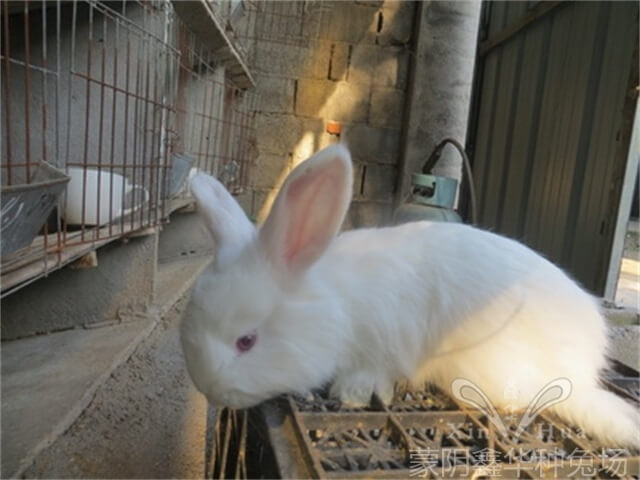许多新手,在养兔初期,比如,东找西问进了30~50个亦或是100个种兔,开始养的时候,胎~第二胎,发情,配种,繁育都比较顺利,窝产率也比较高,虽然没做多少必须做的免疫及管理琐事,存活率也是非常的高,个别甚可以达到95%左右。
Many novices, in the early stage of raising rabbits, for example, looked for and asked around, and finally entered 30-50 or 100 breeding rabbits. At the beginning of raising, the first to second fetuses, estrus, breeding and breeding were relatively smooth, and the nest yield was relatively high. Although they did not do many necessary immunization and management chores, the survival rate was also very high, and some even reached about 95%.
看着一窝一窝精灵一样的小兔子,实在喜欢人,到了该卖的时候,看看哪个兔子都不舍得卖,就连根本不可以做种的兔子和携带各种各样病菌的都不舍得卖,都想留种,发展壮大。
Looking at a nest of ELF like rabbits, I really like people. When it's time to sell, see which rabbit is not willing to sell. Even rabbits that can't be planted at all and those carrying all kinds of germs are not willing to sell. They all want to keep seeds and grow.
并暗自得意:这养兔子好像也没多难呀,我没什么经验和技术不也养的非常好嘛。且慢得意,到了第三~第四胎,发情也难了,配种也难了,实际受孕率更是凤毛麟角啦,不管怎么配,甚是配了三~四次也受孕不了,兔场的各种各样问题也都随之而来。折腾来折腾去,就是搞不明白什么原因。
And secretly proud: it doesn't seem very difficult to raise rabbits. I don't have much experience and technology. I don't also raise rabbits very well. Wait and be proud. When you get to the third to fourth fetus, it's difficult to estrus and breeding. The actual pregnancy rate is even rare. No matter how you match it, you can't get pregnant even after three to four times. All kinds of problems in the rabbit farm follow. Toss around, just don't understand why.

其实,原因也不复杂, 胎~第二胎容易发情配上并成功受孕,那是因为这些新手一般都是买的商品兔(名誉上都是种兔,并且花的也是种兔的价钱)做的种兔,因为没有繁育过,前期累积的养分可以基本保证正常的发情和繁育。到了第三~第四胎,因为,前面不懂防疫及管理,由于怀孕,哺乳身体透支过大,营养基本都是缺乏严重,又加上预防基本都是没有跟的上,各种病菌毒从四面八方侵入,需要补充营养的没能及时弥补,后期肌体已经完全失衡,基本都是营养跟不上又加上许多疾病傍身,所以就很难再出现前期那样的正常发情,容易发情,配种,顺利繁育那样的容易事了,要知道,一个母兔一旦营养缺失,没有半个月以上,甚更长的时间是很难再恢复到正常或者接近健康度的,这需要几个方面的配合和跟进,才可以慢慢恢复如初,(具体补充护理见我文章:初胎母兔的孕期管理。)。
In fact, the reason is not complicated. The first to second fetuses are easy to estrus and get pregnant successfully. That's because these novices usually buy commercial rabbits (they are breeding rabbits in reputation and spend the price of breeding rabbits). Because they have not been bred, the nutrients accumulated in the early stage can basically ensure normal estrus and breeding. When we arrived at the third to fourth fetus, because we didn't understand epidemic prevention and management in the front, because of pregnancy, excessive overdraft of breast-feeding body, serious lack of nutrition, and basically no follow-up of prevention, all kinds of bacteria and viruses invaded from all directions, and those who needed to supplement nutrition failed to make up in time, and the body was completely unbalanced in the later stage, Basically, nutrition can't keep up, and many diseases are close to the body, so it's difficult to have such easy things as normal estrus, easy estrus, breeding and smooth breeding in the early stage. You know, once a female rabbit lacks nutrition, it's difficult to return to normal or close to health for more than half a month or even longer, This requires the cooperation and follow-up of several aspects before it can recover slowly. (for specific supplementary care, see my article: pregnancy management of newborn female rabbits.).
这个时间如果能够及时补救,还不是太晚,可惜,许多养兔新手没有及时跟进亡羊补牢,找出不足,加以弥补。而是拼命想发展扩大,不愿或者不舍得淘汰早应该淘汰的病兔及不适合做种的兔子,并卖出前几胎所生的商品兔以缓解经济上的压力和种群不合理的扩大。就这样,为了发展而发展,结果兔子是多了,可饲料、预防药品、人工、水电及未知风险都在逐步加大,弄的自己疲惫不堪,经济压力陡增,这个时候才感到养兔不容易,更没有自己当初想像的那样容易了。
If this time can be remedied in time, it is not too late. Unfortunately, many novices who raise rabbits do not follow up in time, find out the deficiencies and make up for them. Instead, they desperately want to develop and expand, are unwilling or unwilling to eliminate the sick rabbits that should have been eliminated and the rabbits that are not suitable for breeding, and sell the commercial rabbits born from the first few births to alleviate the economic pressure and unreasonable expansion of the population. In this way, in order to develop, there are more rabbits. However, feed, preventive drugs, labor, water and electricity and unknown risks are gradually increasing. They are exhausted and the economic pressure increases sharply. At this time, they feel that raising rabbits is not easy, let alone as easy as they thought.


 发布日期:2021-08-07
来源:http://www.myxinhua.com 发布人:admin
发布日期:2021-08-07
来源:http://www.myxinhua.com 发布人:admin